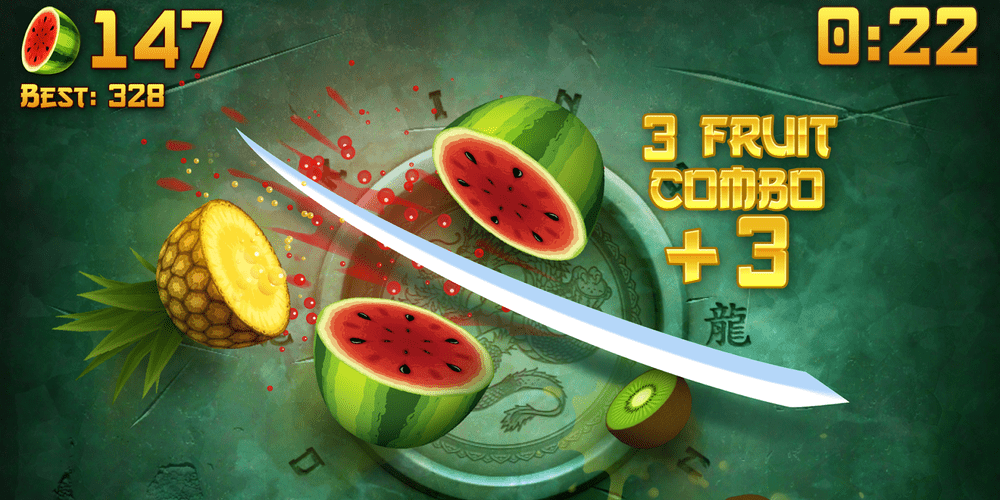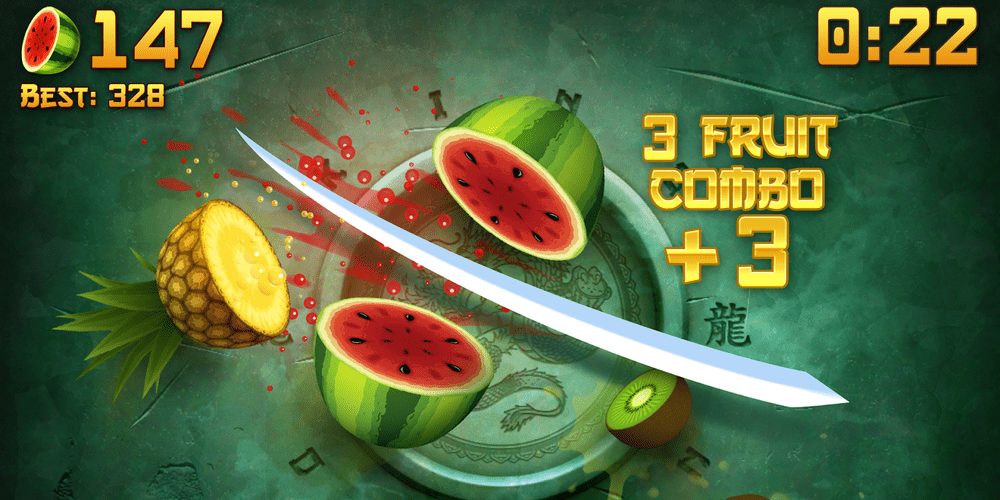Slice Slice Baby: An Homage to Fruit Ninja


I have two memories from my childhood of playing Halfbrick’s groundbreaking 2010 game, Fruit Ninja. The first was in 2012, when Hurricane Sandy struck the East Coast from Canada to the Caribbean. Like many families, the Brandfonbrener household was left without electricity. For two weeks, my brother, sister and I confronted the same biting early November temperatures as students currently face on Amherst campus.
To distract ourselves from the cold, we played Fruit Ninja. My brother’s iPhone 4S (which he could charge at school) became a little portal to normal times. Gathered around the colorful, flashing lights of the tiny screen, we chopped pineapples and coconuts by candlelight.
My other memory of Fruit Ninja is, in many ways, the opposite experience. A few months after Hurricane Sandy, my family and I went on vacation. Basking in tropical warmth, enjoying (mock) cocktails and lots of free time, the frigid power outage a few months earlier was a distant memory.
But during the lazy vacation moments when other people sunbathed, we played Fruit Ninja. There was something naughty about using that precious family time so trivially. And that made it all the more satisfying.
Here’s what you should take from those anecdotes: no matter the circumstance, Fruit Ninja is addictive.
It’s all a part of the game design. Halfbrick has made an app chalk full of psychological traps, compelling you to play “just one more game.” There are three modes of play: Classic, Zen and Arcade. It feels like Halfbrick has devoted all of their resources to Arcade Mode. All of its special features are absent in the other two modes. You might think that this is bad game design. Why make three modes when only one of them is playable?
Play a round of Arcade mode. There’s your answer: it’s just that fun.
The structure is simple. It’s one minute of fruit slashing. One fruit slashed equals one point. But you’re not just slashing supermarket staples like apples and pears. There are three special, glowing bananas that change the nature of the game. The Freeze Banana slows down time, halting the one-minute countdown and making it easier to score combos — that is, slicing three or more fruit with a single stroke, which gives twice as many points. The Blitz Banana sends a copious amount of fruit flying onto the screen, making it easy to rack up points through combos. Finally, the Double Banana doubles any points, even additional combo points, you get during its timer.
These three power-ups are designed around encouraging the player to focus on getting combos. Indeed, this is the way the game lets you reach high scores. It’s all about combos. The first step is to quickly make combos involving at least eight fruits: say, a combo of five followed by a combo of three, or a combo of four, then three, then three.
Once this happens, the game enters a “combo blitz,” granting five bonus points and increasing the pace of the game. Then you do it all over again. Another set of combos of at least eight fruits. The combo blitz increases and increases, giving you even greater point bonuses each time. The fruit gets faster and faster, the music speeds up and the background rolls and vibrates excitedly.
The combo blitz feature is the main reason why the game is so addictive. It requires intense focus to maintain a blitz. Fruit can be difficult to combo, requiring twisty strokes of the “blade.” If you do not make combos quickly enough, the blitz will end, and the game will slow back down. You also have to carefully avoid bombs, which immediately end your blitz and return the game to the same slow speed as the start of the round. Hitting one is the worst feeling, like stepping on a Lego.
Conversely, keeping up the blitz feels great. If you manage to have two of the special bananas active at once, both effects activate. So the fruit can be slowed by the Freeze Banana but also drastically increased in number by the Blitz Banana. This makes huge combos with more than 10 fruits possible. Pairing either of those bananas with the Double Banana still doubles your points. And having all three bananas active at once is the best feeling. It’s almost as if time stops in the real world, and all there is to do is slash the fruit.
This combo-based point system takes inspiration from traditional Japanese fighting games like “Street Fighter” and “King of Fighters.” These games required players to string together complex sequences of button inputs to “juggle” the opposing fighter, preventing them from using their own button inputs. Before the age of widespread household gaming consoles, people played these games in arcades; it’s fitting, then, that Fruit Ninja’s Arcade mode was named as such. But instead of intricate combinations of buttons, you simply drag your finger on the screen.
Much like how arcade games repeatedly demand coins, mobile games allow companies to make a profit through repeated microtransactions. In Fruit Ninja, you can spend “Starfruit,” the in-game currency, to buy additional power-ups. This doesn’t require actual money, though, because you accumulate starfruit simply by playing. So there’s no reason not to buy the powerups, and so, there’s no reason to stop playing. This is a fundamental part of mobile game design. By creating the illusion of choice, the game tricks the player into thinking that they have agency.
Through its careful, challenging and captivating game design, and a physics engine that was cutting edge at the time of the game’s release, Fruit Ninja is still one of the best mobile games available, even compared to its sequel, Fruit Ninja 2.
For devoted video game fans, mobile games have a bad reputation: unfulfilling gameplay marred by microtransactions. Fruit Ninja argues against such thinking. There’s something soothing about picking up a round or two of Fruit Ninja in the middle of the day — exactly when you should be productive — and succumbing to the pitter-pattering splashes of sliced fruit.